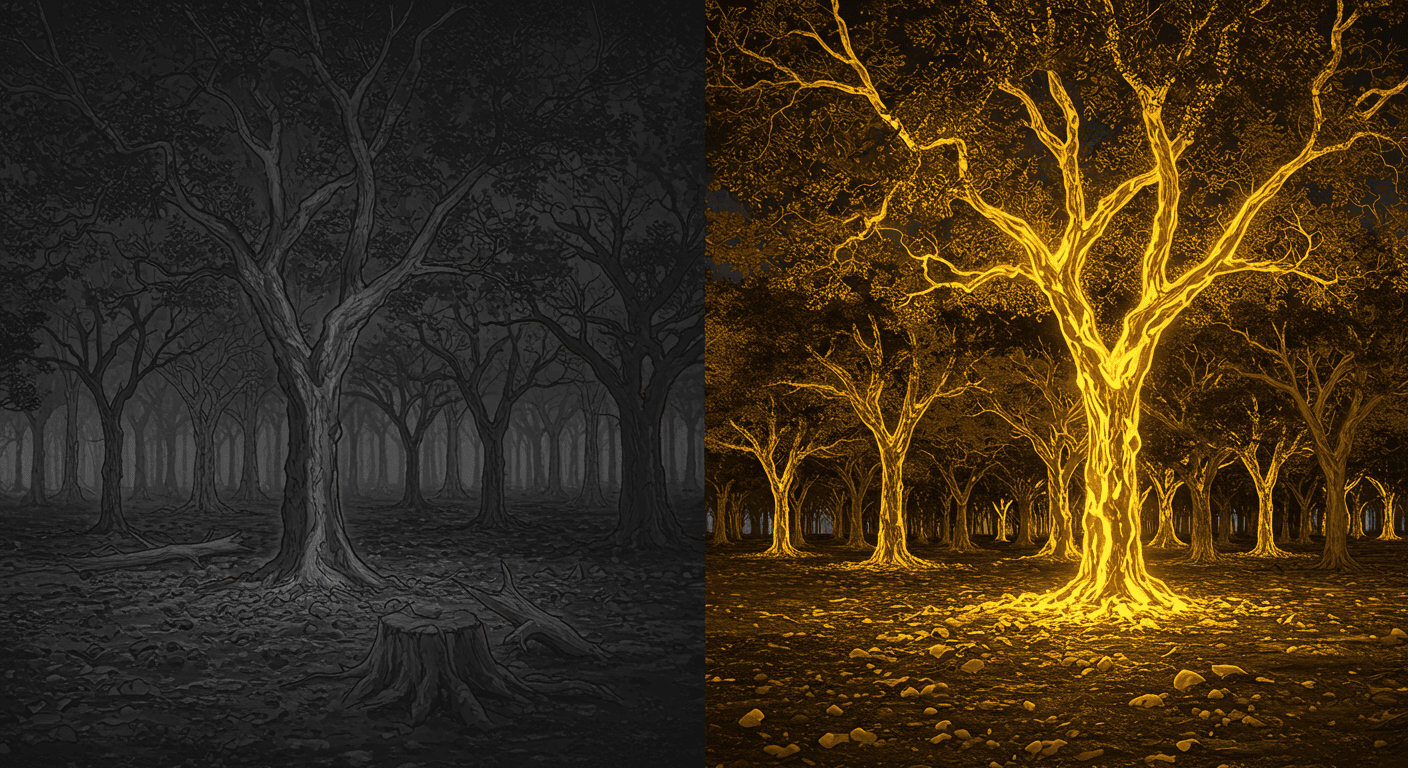The story of oud is a dramatic tale of scent, scarcity, and survival. For centuries, this treasured resin, born from the wounded heartwood of the Aquilaria tree, has been synonymous with ultimate luxury, its price often surpassing that of gold. This immense value, however, cast a long shadow, fueling a relentless wave of illegal poaching that pushed wild Aquilaria populations to the brink of extinction and destabilized entire ecosystems.
This crisis sparked a quiet but powerful revolution in the world of perfumery and agriculture: the rise of cultivated oud plantations. This shift represents more than just a new farming technique; it is a strategic economic counter-offensive against the destructive black market. By transforming out from a hunted treasure into a cultivated crop, investors are systematically dismantling the very financial incentives that drive poachers into the wild. This change is fundamentally reshaping the supply chain, making the future of this ancient scent dependent not on chance discovery, but on patient, deliberate investment.
The core principles behind this transformation are not isolated to a single ingredient; they reflect a broader trend across the luxury materials sector. Just as investment in oud cultivation addresses scarcity and illegality, similar economic and ethical pressures are forcing changes in how other key perfume components are sourced. This dynamic is particularly evident in the growing focus on international fragrance regulations, which govern the trade of endangered species like rosewood and dictate the very composition of future scents.
The Vicious Cycle of Poaching
The traditional pursuit of wild oud is inherently destructive, a stark contrast to the meticulous art it ultimately serves. Poachers venture deep into ancient forests, often indiscriminately felling vast numbers of Aquilaria trees in the hope of finding one that has naturally developed the precious, dark resin. This process is tragically inefficient, as only a small percentage of wild trees, typically those infected by a specific mold, ever produce oud, leaving a trail of environmental devastation for a minimal yield.
This brutal methodology creates a devastating feedback loop of economic and ecological ruin. The increasing rarity of resin-bearing trees drives the market price of wild oud to astronomical heights, which in turn makes the high-risk endeavor of poaching even more financially attractive to impoverished local communities. These communities, often lacking other economic opportunities, become trapped in a cycle of participating in the destruction of their own natural heritage. The result is a market fueled by scarcity and a landscape scarred by these destructive harvesting methods.
Ultimately, the entire system is built on a foundation of diminishing returns. Each felled tree that does not contain oud represents a net loss for the ecosystem and pushes the species closer to vanishing entirely. For the fragrance industry, this translates to an unstable, unpredictable, and ethically compromised supply chain. The allure of wild oud, steeped in tradition and mystique, is overshadowed by the grim reality of its origin story, making a sustainable alternative not just preferable, but essential for survival.
Plantation Oud as a Sustainable Solution
The emergence of cultivated oud offers a powerful antidote to the poison of poaching. This approach domesticates the Aquilaria tree, moving it from the endangered wilds into the controlled environment of a dedicated plantation. Here, the trees are grown specifically for the purpose of oud production, creating a renewable and predictable source that does not threaten the fragile existence of their wild counterparts. This agricultural pivot is the first critical step in breaking the cycle of destruction.
The true innovation, however, lies in simulating the tree’s natural defense mechanism. Instead of waiting decades for random mold infections, cultivators use a range of proprietary techniques to artificially inoculate the trees, stimulating the controlled formation of the valuable resin. This process, which can take several years, is a blend of agricultural science and patient observation, turning what was once a game of chance into a predictable manufacturing timeline. It allows for a consistent, scalable supply that the wild could never sustainably offer.
The benefits of this model create a ripple effect of positive change, addressing the key failures of the traditional system. This modern approach provides a host of advantages:
- It actively protects the remaining wild Aquilaria populations from human predation.
- It establishes a stable, reliable, and ethically transparent supply chain for the global fragrance market.
- It generates long-term, legitimate economic opportunities and skilled jobs for local agricultural communities.
- It allows for greater control over the final chemical profile and quality of the oud produced.
The Investment Landscape
The transition to cultivated oud is being propelled by a diverse and forward-thinking group of investors. These are not typical speculators, but a coalition of agricultural investment funds, specialized asset management firms, and even major luxury brands seeking to secure their future supply chains. They recognize that the long-term value of a sustainable oud market far outweighs the short-term profits of the volatile and destructive black market. These investors are playing a long game, planting the seeds for a stable and ethical industry.
This form of agricultural investment requires a unique kind of financial patience and foresight. An Aquilaria tree may need to grow for seven to ten years before it is even ready for the inoculation process, with the resin itself taking several more years to mature to a high quality. Investors, therefore, are not looking for quick returns but are committing capital for a decade or more, banking on the predictable future demand for a verifiably sustainable luxury product. This long-term commitment is what builds the foundation of a market resilient enough to challenge and replace the poaching economy.
The strategic genius of this investment model is that it attacks the black market at its source: profitability. By methodically increasing the global supply of high-quality, ethically produced oud, plantations exert a downward pressure on the price of illegally harvested resin. This systematically erodes the financial incentive for poachers, making the dangerous and illegal work less and less rewarding compared to the stable, legal employment offered by the growing plantation sector.
Quality, Consistency, and the Future
A persistent debate within the world of perfumery centers on the perceived difference in quality between wild and cultivated oud. Aficionados of wild oud often speak of an unparalleled complexity and depth, a “spirit of the jungle” that cannot be replicated. While it is true that centuries-old wild resin possesses a unique character, this romantic notion often overlooks the extreme inconsistency and rampant adulteration found within the illegal market.
The controlled environment of a plantation offers the solution to this very problem. Through meticulous management of tree genetics, soil conditions, and inoculation techniques, producers can aim for specific scent profiles and ensure a level of purity that is nearly impossible to guarantee with poached oud. This focus on consistent quality control means that perfumers and brands can rely on a predictable raw material, allowing for greater artistry and less variability in their final creations. Technology and science are closing the quality gap, replacing inconsistency with reliability.
Looking ahead, the future of oud is undoubtedly rooted in cultivation. As plantation-derived oud becomes the industry standard, it will not only ensure the survival of the Aquilaria tree but also democratize access to this once impossibly rare ingredient. This shift guarantees that the legacy of oud—its deep, resonant, and evocative scent—can be preserved and shared for generations to come, built not on a foundation of destruction, but on one of sustainable investment and innovation.
Frequently Asked Questions
Yes, absolutely. It originates from the same Aquilaria tree species and is formed through the same biological process of resin production in response to stress. The only difference is that the stress factor is induced by humans in a controlled, agricultural setting rather than occurring by chance in the wild, which ensures the tree’s survival and a sustainable harvest.
Investment combats poaching on two economic fronts. First, it creates legitimate, stable, and often better-paying jobs in agriculture and processing for local communities, removing the financial desperation that often leads people to poach. Second, by increasing the reliable supply of high-quality oud, it lowers the global market price, which systematically erodes the extreme profitability of the dangerous and illegal black market for wild oud.
While theoretically possible, successful oud cultivation is a highly specialized and capital-intensive endeavor. It requires specific knowledge of Aquilaria tree husbandry, proprietary inoculation techniques, and significant long-term investment capital to cover the decade or more before a return is realized. It is far more complex than a typical agricultural crop, demanding a unique blend of scientific expertise and financial patience.

